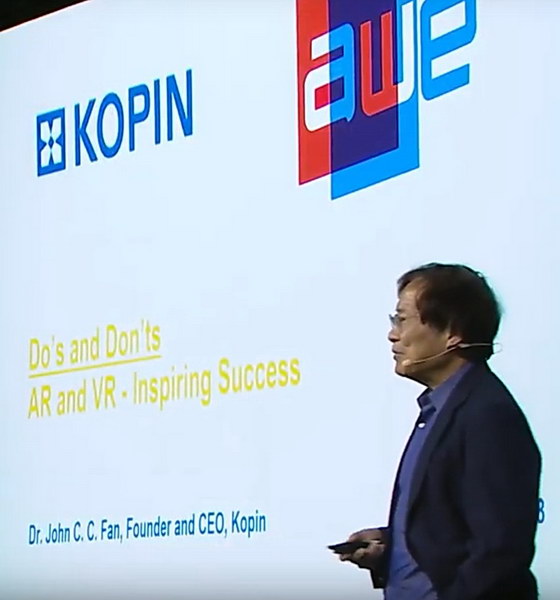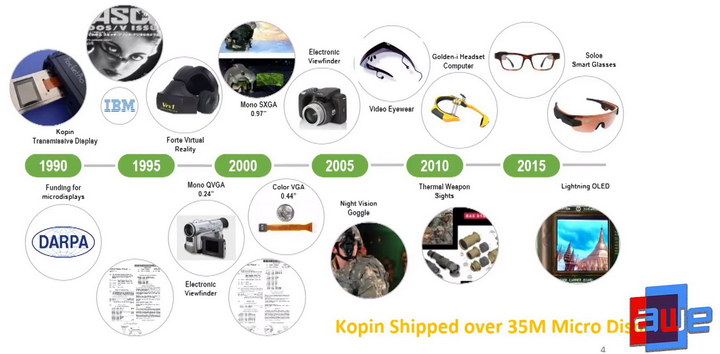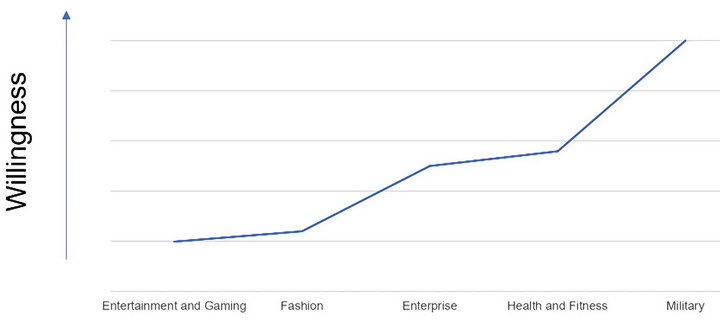In 2017, Kopin announced a new product line, the Brillian LCD microdisplay, which targeted military HMD applications. On September 5, 2019, the announced the first design win for the display, for an augmented reality (AR) head mounted display (HMD) for use by Army helicopter pilots.

(Note: There is no relationship between Kopin’s Brillian product line and the LCoS and RPTV manufacturer Brillian Corporation that became Syntax-Brillian in 2005 and went bankrupt in 2009, in case you are old enough to remember RPTV and wonder about this.)
Kopin SXGA LBC CyberDisplay, said to be nearly identical to the Brillian SXGA device. (Credit: Kopin)
The display chosen for the Army HMD is a transmissive color filter array (CFA), SXGA (1280 x 1024) LCD microdisplay with a 0.97” (24.6mm) diagonal size and a pixel pitch of 5 ?m x RGB x 15 ?m. The brightness achieved will depend on the backlight used to illuminate the LCD and Kopin says the device is capable of more than 34,000 nits. This very high brightness is need for two reasons. First, see-through AR HMDs are typically very inefficient and need a very bright source to produce enough light for the image to be visible. Second, the images and graphics in an aviation AR HMD must be bright enough for the pilot to see them against, for example, a white cloud layer beneath him in direct sunlight.
I got in touch with Hong Choi, Kopin’s Chief Technology Officer since September 2000, to see if more details on the display itself or the system it will be used in were available. He said the Brillian SXGA imager was nearly identical to the commercial SXGA LBC CyberDisplay. He added “The backplane design is almost the same but there are some changes to the design and process to enhance the performance.” He said that he could not reveal who the HMD manufacturer will be.
Dr. Choi also told me the SXGA device was still the only microdisplay in the Brillian product line. “We are working on different Brillian displays but they are not ready for production yet,” he said.
President and CEO of Kopin, Dr. John C. C. Fan, said,
“We are very pleased to have the Brillian LCD designed into a color HMD for the US Army helicopters. It has been very challenging to provide color HMDs for pilots because historically color microdisplays could not offer super high brightness with good contrast required for the application. Full-color Brillian displays exhibit brightness levels greater than 34,000 nits (10,000 foot-lamberts) and contrast ratios higher than 300:1. The Brillian display exhibits approximately double the contrast ratio and color transmission of our standard LC microdisplays.”
Bill Maffucci, the Company’s VP and General Manager of Government and Industrial Products added,
“Kopin Brillian displays have become the microdisplay of choice for pilots’ color HMDs where high brightness is required to provide color symbology that is easy to read in full sunlight conditions. The Brillian display far exceeds emissive devices in brightness, operating life and reliability, allowing pilots to maintain situational awareness in extreme operating environments.”
Of course, when Maffucci referred to “emissive displays” he was talking about the current generation of high-brightness OLED microdisplays coming from companies like eMagin and suited for use in HMDs. When the next-generation of microLED microdisplays come along and are designed into HMDs, they are likely to have both higher brightness, higher contrast and longer life than even Kopin Brillian devices.
 Kopin’s John Fan Discusses AR and VR at AWE 2018 (Credit: AWE)
Kopin’s John Fan Discusses AR and VR at AWE 2018 (Credit: AWE)
At Augmented World Expo (AWE) 2018, Kopin’s John Fan discussed the do’s and don’ts of AR and virtual reality (VR). Since Kopin has been making AR HMDs for about 30 years, his experiences are worth paying attention to. For example, when IBM worked with MIT and built a head-wearable computer in 1993, the system used a Kopin display, according to Dr. Fan.
 Kopin has been making displays for HMDs for almost 30 years. (Credit: Kopin)
Kopin has been making displays for HMDs for almost 30 years. (Credit: Kopin)
 Wearable PC prototype with near-eye display from Kopin from a 1990s IBM TV ad. (Credit: IBM)
Wearable PC prototype with near-eye display from Kopin from a 1990s IBM TV ad. (Credit: IBM)
He said that each generation of computer; mainframe (1960), desktop (1980), laptop (1990), smartphone (2008) and wearable (2018); has progressed from military to enterprise to consumer use over time. He expects this progression to continue for wearable computers and displays. After all, the best HMDs around today are for military applications. Perhaps the best HMD of all is the $400,000 Mixed Reality (MR) helmet from Collins Aerospace (formerly Rockwell Collins), designed for pilots of the new F-35 aircraft from Lockheed Martin. BTW, Kopin makes the display for that system, too.
He also said that when a new computer generation was introduced, it had less power than the previous generation. For example, when laptops were introduced in about 1990, they had less power than the 1990 desktops. It took a few years for laptops to catch up with the power of 1990 desktops but by then desktops had advanced to the point that they were still more powerful than laptops. He said current wearables have modest computing power compared to cell phones, but still have enough power to do certain jobs without a host computer, like track heart rate and count paces.
One flaw in Dr. Fan’s argument, at least from the point of view of a display company like Kopin or a column like Display Daily, is that wearables need not be computers – they are displays for the powerful computer you carry in your pocket called a smartphone. Wireless technology makes it unnecessary in most cases for a wearable to have more computer capabilities than communication and display drivers.
At AWE, Dr. Fan gave five do’s and don’ts for AR systems. Given his experience with AR, these are worth considering when designing a new product. They are:
- Humans first – Prioritize human ergonomics and experience first and technology second.
- Physical world first – Deliver relevant AR overlays in small controlled bursts so you don’t overwhelm the user.
 A driver’s HMD should only deliver information relevant to driving, not extraneous content. (Credit: Kopin)
A driver’s HMD should only deliver information relevant to driving, not extraneous content. (Credit: Kopin)
- Maintain Situational awareness – Preserve real world contact and social acceptability
- Voice is the new touch – Display is critical but AR HMDs must also allow for audio command and control.
- Balance design with benefits – Do not overdesign with unnecessary features.
 Qualitative willingness of various categories of users to actually wear AR HMDs (Credit: Kopin)
Qualitative willingness of various categories of users to actually wear AR HMDs (Credit: Kopin)
This last design commandment requires not just consideration of the design vs benefit of the HMD, but the willingness of the target category of user to actually wear a HMD – Dr. Fan says people don’t actually like to wear things on their head. Military personnel are willing to wear HMDs because they can, literally, save their lives. People are willing to wear health and fitness things like eyeglasses on their head because of the very visible benefits. Entertainment and gaming users? Not so willing, unless they can see a compelling benefit. I see this as one reason why many AR consumer apps in 2019 seem to more designed around the smartphone screen than an HMD. Another key reason is the relatively poor quality of the images generated by commercially available AR HMDs. A third reason is the relatively “geeky” appearance of a typical consumer HMD.
Dr. Fan also has five commandments for designers of VR systems, but I’ll only focus on two of them. First, don’t try to make the VR world too big, (i.e. to big a field of view (FOV)). In displays, sharpness is everything. Once you have an image with good resolution and sharpness, as display technology improves and has more pixels (e.g. 4K and 8K), you can expand the FOV.
His last VR commandment is something all VR HMD manufacturers and content creators for those HMDs should consider: Don’t close off the outside world completely. Since Fan and Kopin have a strong military background, he used the phrase “situational awareness.” He said that VR HMD wearers can rarely tolerate more than about 20 minutes of VR HMD use where the outside world is cut off completely. And, of course, if the outside world is completely cut off, realistically, the HMD and the app driving it can only be used while seated and can’t be used by a mobile user. – Matthew Brennesholtz

